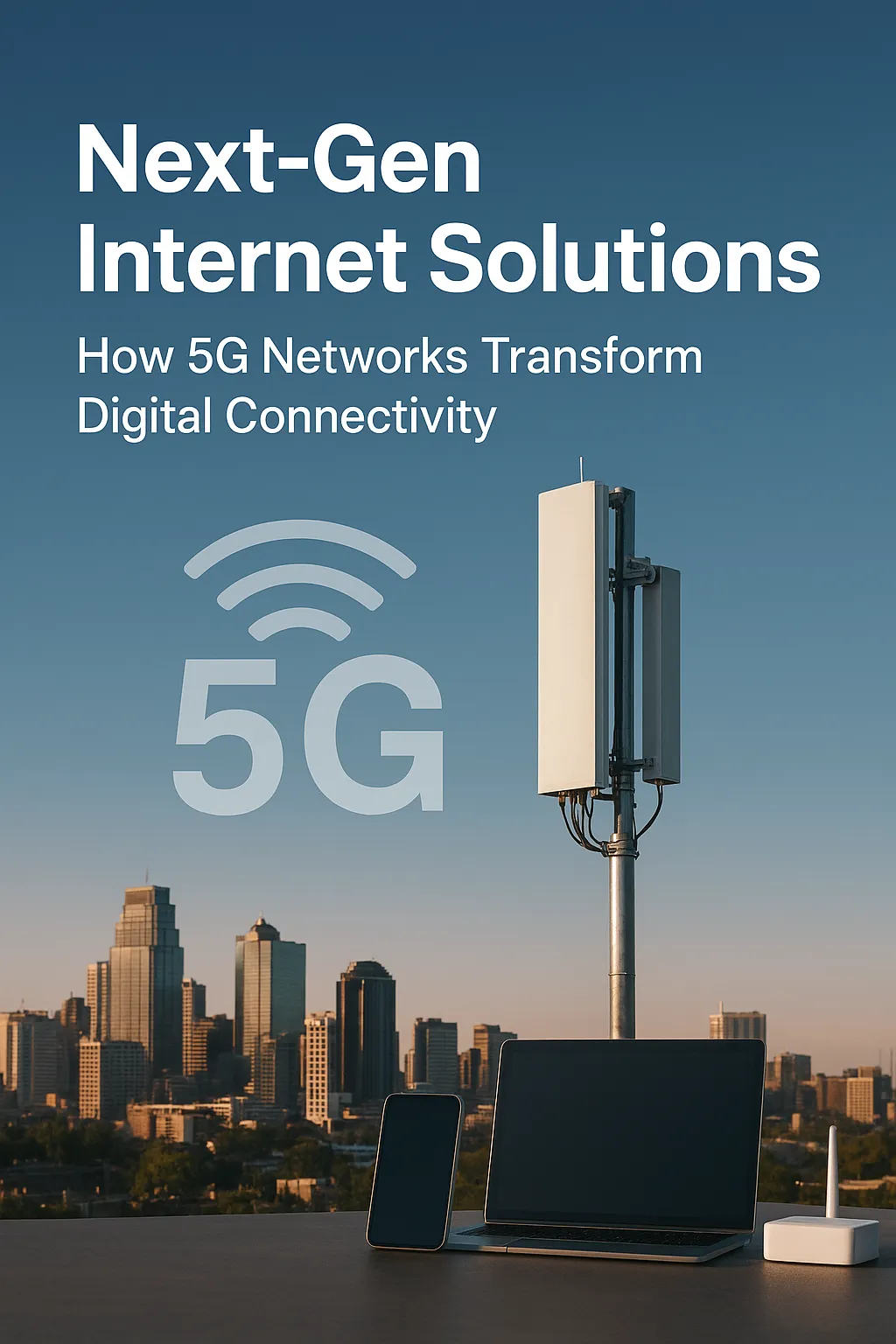Next-Gen Internet Solutions: How 5G Networks Transform Digital Connectivity
Fifth-generation wireless technology represents a quantum leap in mobile communications, delivering speeds up to 100 times faster than 4G networks. This revolutionary advancement operates across three distinct spectrum bands: low-band frequencies for wide coverage, mid-band for balanced performance, and high-band millimeter wave frequencies for maximum speed in dense urban areas.
The architecture of 5G networks employs advanced technologies including massive MIMO (Multiple Input, Multiple Output) antenna arrays, beamforming capabilities, and network slicing. These innovations enable simultaneous connections for millions of devices while maintaining consistent performance across diverse applications. Understanding 5G Technology Fundamentals
Understanding 5G Technology Fundamentals
Fifth-generation wireless technology represents a quantum leap in mobile communications, delivering speeds up to 100 times faster than 4G networks. This revolutionary advancement operates across three distinct spectrum bands: low-band frequencies for wide coverage, mid-band for balanced performance, and high-band millimeter wave frequencies for maximum speed in dense urban areas.
The architecture of 5G networks employs advanced technologies including massive MIMO (Multiple Input, Multiple Output) antenna arrays, beamforming capabilities, and network slicing. These innovations enable simultaneous connections for millions of devices while maintaining consistent performance across diverse applications.
Key Performance Indicators
5G networks achieve remarkable technical specifications that surpass previous generations. Peak download speeds reach 10 gigabits per second, while upload speeds can exceed 1 gigabit per second. Network latency drops to as low as 1 millisecond, enabling real-time applications that were previously impossible.
Connection density supports up to 1 million devices per square kilometer, making 5G ideal for Internet of Things deployments. Energy efficiency improvements reduce network power consumption by up to 90% compared to 4G infrastructure.
Infrastructure and Deployment Strategies
The deployment of 5G networks requires substantial infrastructure investments and strategic planning. Telecommunications companies must install thousands of small cell towers, upgrade existing macro cell sites, and implement fiber optic backhaul connections to support the increased data demands.
Network operators utilize various deployment models including standalone 5G networks that operate independently and non-standalone versions that leverage existing 4G infrastructure. This hybrid approach allows for gradual migration while maintaining service continuity.
Spectrum Allocation and Management
Effective spectrum management plays a crucial role in 5G deployment success. Regulatory bodies worldwide have allocated specific frequency bands for 5G operations, balancing coverage requirements with capacity needs. The coordination of spectrum usage prevents interference and ensures optimal network performance.
Dynamic spectrum sharing technologies enable efficient utilization of available frequencies by automatically adjusting allocations based on real-time demand patterns. This intelligent resource management maximizes network efficiency while reducing operational costs.
Revolutionary Applications and Use Cases
5G networks unlock transformative applications across multiple industries and sectors. Enhanced mobile broadband provides consumers with lightning-fast internet access for streaming high-definition content, cloud gaming, and immersive virtual reality experiences.
Ultra-reliable low-latency communications enable critical applications in healthcare, autonomous vehicles, and industrial automation. These mission-critical services require guaranteed performance levels that only 5G networks can reliably deliver.
Smart City Integration
Urban environments benefit significantly from 5G-enabled smart city solutions. Traffic management systems utilize real-time data processing to optimize traffic flow and reduce congestion. Smart lighting networks adjust brightness based on pedestrian activity and environmental conditions.
Public safety applications include high-definition video surveillance, emergency response coordination, and disaster management systems. These capabilities enhance urban security while improving response times for critical incidents.
Healthcare Innovation
Medical applications leverage 5G's low latency and high reliability for remote surgery, telemedicine consultations, and real-time patient monitoring. Surgeons can perform complex procedures using robotic systems controlled from distant locations with precision matching in-person operations.
Wearable health devices continuously monitor vital signs and instantly transmit data to healthcare providers. This constant connectivity enables proactive medical interventions and personalized treatment plans based on real-time patient data.
Industrial Transformation and Automation
Manufacturing industries experience dramatic efficiency improvements through 5G-enabled automation systems. Smart factories utilize connected sensors, robotic systems, and artificial intelligence to optimize production processes and reduce downtime.
Predictive maintenance applications analyze equipment performance data in real-time, identifying potential failures before they occur. This proactive approach minimizes production disruptions and extends equipment lifespan.
Supply Chain Optimization
Global supply chains benefit from 5G connectivity through enhanced tracking and monitoring capabilities. Real-time visibility into inventory levels, shipment status, and logistics operations enables more efficient resource allocation and reduced operational costs.
Automated warehouses utilize 5G networks to coordinate robotic systems, inventory management, and order fulfillment processes. This integration creates seamless operations that adapt dynamically to changing demand patterns.
Edge Computing Integration
The convergence of 5G networks with edge computing creates powerful distributed processing capabilities. By placing computing resources closer to end users, edge computing reduces latency and bandwidth requirements while improving application performance.
Multi-access edge computing platforms enable real-time data processing for time-sensitive applications including autonomous vehicles, augmented reality, and industrial control systems. This distributed architecture enhances responsiveness while reducing dependency on centralized cloud infrastructure.
Network Function Virtualization
Software-defined networking principles enable flexible network management and service deployment. Virtual network functions can be instantiated on-demand, allowing operators to rapidly deploy new services and adapt to changing requirements.
Network slicing technology creates dedicated virtual networks for specific applications or customers. Each slice can be optimized for particular performance characteristics, ensuring quality of service for diverse use cases.
Security and Privacy Considerations
5G networks incorporate advanced security features including enhanced encryption algorithms, network access controls, and user privacy protections. These measures address growing concerns about data security and unauthorized access to network resources.
Zero-trust security models assume no implicit trust within the network, requiring continuous verification of all connections and communications. This approach provides comprehensive protection against sophisticated cyber threats.
Regulatory Compliance
Telecommunications operators must navigate complex regulatory requirements while deploying 5G networks. Privacy regulations such as GDPR and CCPA impose strict requirements for data handling and user consent management.
International standards organizations collaborate to establish common security frameworks and interoperability requirements. These standards ensure consistent security practices across different regions and network operators.
Economic Impact and Market Opportunities
The economic impact of 5G deployment extends far beyond telecommunications infrastructure. New business models emerge as organizations leverage enhanced connectivity to create innovative products and services.
Market research indicates that 5G technologies will contribute trillions of dollars to global economic output through productivity improvements, new service categories, and enhanced competitiveness across industries.
Investment and Funding Landscape
Public and private investment in 5G infrastructure reaches unprecedented levels as organizations recognize the strategic importance of advanced connectivity. Government initiatives support deployment through funding programs, tax incentives, and regulatory streamlining.
Venture capital funding flows into 5G-enabled startups developing innovative applications and services. These investments drive technological advancement and accelerate market adoption of next-generation solutions.
Future Developments and Evolution
The evolution of 5G technology continues with ongoing research into 6G networks and beyond. Advanced features under development include enhanced artificial intelligence integration, improved energy efficiency, and expanded coverage capabilities.
Satellite integration expands 5G coverage to remote areas and mobile platforms including aircraft and maritime vessels. This global connectivity enables new applications and services that were previously impossible due to geographic limitations.
Research organizations worldwide collaborate on next-generation wireless technologies that will further enhance network capabilities and enable new categories of applications. These developments ensure continued innovation in telecommunications infrastructure.
Sustainability and Environmental Impact
Environmental considerations play an increasingly important role in 5G network design and deployment. Energy-efficient hardware, renewable power sources, and optimized network architectures reduce the environmental footprint of telecommunications infrastructure.
Circular economy principles guide equipment lifecycle management, promoting reuse, recycling, and sustainable manufacturing practices. These initiatives minimize waste while maintaining high performance standards.
The transformative potential of 5G networks extends across all sectors of the economy, creating opportunities for innovation, efficiency improvements, and new business models. As deployment continues worldwide, the full impact of this revolutionary technology will reshape how we live, work, and interact with digital systems.











